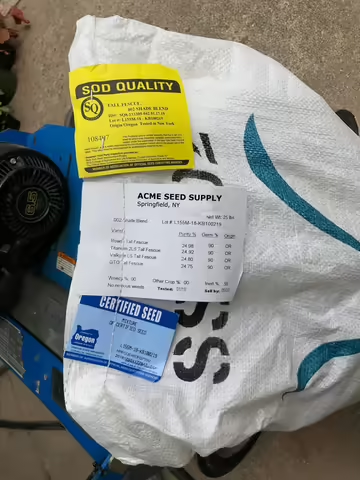URBANA, Ill. – No two bags of grass seeds are the same. From cool-season grasses for urban lawns to agriculture grass crop species feeding livestock, each variety has different traits that will thrive or fail depending on where it’s planted.
“How long does one take to purchase a new vehicle?,” says Maria Turner, Extension specialist. “Some people spend months researching and comparing features. The same thought and care should also be taken when choosing the seed for your lawn.”
Picking appropriate seeds is the most critical investment in ensuring a high-quality turf that lasts. University of Illinois Extension provides additional information in its online Home, Yard, and Garden newsletter.
Late summer or early fall is the best time to plant cool-season grass seed. When planted at least 45 days before the first fall frost, the grass will be able to establish roots in ideal soil and air temperatures and be ready come spring.
The National Turfgrass Evaluation Program evaluates turfgrass varieties in the United States. Its results can help managers choose a variety adapted to their area and expected level of maintenance.
“These trials look at characteristics, such as color, disease resistance, drought tolerance, winter hardiness, traffic tolerance, and mowing height,” Turner says. “This is a great step in determining what cultivars will do the best in your lawn.”
Once a variety has been chosen, it is time to find the seed. Federal law requires that the seed labels list the seller, lot number, purity percentage, and other factors.
The trick is to understand what the most important label item is as it can make the difference between a turf that will last and one that will not. Purity percentage and seed test dates are key components. Choosing the freshest and highest purity allows for the most excellent chance of high-quality turf.
“Knowing how to read the numbers on the label and understanding the contents in the bag is what is critical for a lasting high-quality turf,” Turner says.
Grass seed label information:
- Name of Seller: Use for reordering.
- Lot Number: Provides system for tracing.
- Seed Variety and Crop Seed Content: Most labels will list the species and variety. If the package reads “variety not stated,” it could be a species or cultivar that is not of the same quality. “Crop Seed Content” represents the percent of agriculture crop seeds in the container. Keep crop seed content as low as possible.
- Last Seed Test Date: Germination percentages decline with age of seed.
- Purity Percentage: This is the percent by weight of each grass variety and kind. For example, a label listing 95% pure tall fescue means it contains 95 pounds of pure tall fescue seed per each 100 pounds of seed.
- Germination: Determines the amount of seed capable of growth, as determined under strict lab procedures with ideal growing conditions.
- Weed Seed: Reflects the percentage of seeds not identified as either pure seed or crop seed. This number should be as low as possible.
- Noxious Weeds: Indicates the number of weed seeds per pound as varies by state.
- Inert Material: Indicates the percentage of contents that will not grow, such as broken seeds, chaff, soil, wood shavings, or empty seed hulls.
- Blue Certification Tag: An optional tag that reflects the seed has met rigid standards of varietal purity.
When purchasing seed, a higher price does not necessarily mean it is a higher quality product, Turner says. "Calculate price per pound of pure live seed to give you a better idea of cost."
For more information about lawn care, visit the Illinois Extension website web.extension.illinois.edu/lawntalk.
SOURCE: Maria Turner, Extension Specialist, University Of Illinois
EDITOR: Emily Steele, Media Communications Coordinator, University of Illinois Extension
ABOUT EXTENSION: Illinois Extension leads public outreach for University of Illinois by translating research into action plans that allow Illinois families, businesses, and community leaders to solve problems, make informed decisions, and adapt to changes and opportunities.
